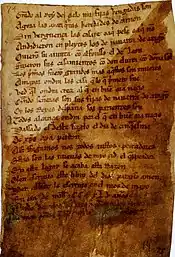Equatorial Spanish
Equatorial Spanish, also called Coastal Colombian-Ecuadorian dialect or Chocoano, is a dialect of Spanish spoken mainly in the coastal region of Ecuador, as well as in the bordering coastal areas of northern Peru and southern Colombia. It is considered to be transitional between the Caribbean dialects and the Peruvian Coast varieties. The major influential linguistic centers are Guayaquil and Buenaventura. There is an important subvariety of this dialect which is spoken by most of the communities of African descent dwelling on the border between coastal Colombia (Chocó department), Ecuador (Esmeraldas province), and Peru (Tumbes Region), and which is said to reflect African influence in terms of intonation and rhythm.
| Spanish language |
|---|
 |
| Overview |
| History |
| Grammar |
| Dialects |
| Dialectology |
| Interlanguages |
| Teaching |

The particular intonation which identifies the speakers of these regions has been a subject of study. Boyd-Bowman (1953) states that the features that he has observed show clearly a phonetic continuity along the coasts of Colombia, Ecuador, and Peru, in contrast to that of their respective Andean provinces.[1] Boyd-Bowman observes that the present borders of Ecuador with the neighboring countries do not correspond to natural geographic boundaries, nor to linguistic/cultural boundaries (the same Spanish is spoken on both sides), nor to older political borders, whether of the Incas or of the Spanish colonies.[2] Lipski (1994) also considers the dialect of northern coastal Peru as a distinct variety of Spanish, based on phonetic features.
Notable phonological characteristics
Equatorial Spanish presents markedly attenuated Caribbean features:
- Syllable-final /s/ is aspirated or elided (although the middle class tends to avoid doing so in the prevocalic environment).
- As in the Caribbean dialects, the /x/ phoneme is realized as [h].
- Word-final /n/ is realized as velar, and sometimes bilabialized, especially among speakers of African descent.
- In rural areas, there is virtually no difference between /l/ and /ɾ/, but elision is rare.
- In the area of Chocó, intervocalic /d/ is realized as [ɾ]. In this same region the aspirated /s/ and /k/ may result in a glottal stop.
- As in virtually all American dialects, seseo is the norm, meaning that the /θ/ phoneme of European Spanish is absent and /s/ is used instead. There are rural areas on the coast of Ecuador, for instance San Lorenzo in Esmeraldas, where the phonetic realization of /s/ is non-sibilant ([θ]), rather than sibilant [s]. This is called ceceo and is uncommon in the Americas (it is also found in some areas of Andalusia).
- Yeismo (merger of traditional /ʎ/ and /ʝ/, with realization as [ʝ]) is also the general rule here, as it is in most of the American Spanish dialects.
References
- "Los apuntes anteriores demuestran claramente la continuidad fonética entre las costas de Colombia, el Ecuador y el Perú [...], frente a la de sus provincias andinas [...]" (p.233).
- "Por ejemplo, las fronteras actuales del Ecuador con los países colindantes no corresponden ni a fronteras naturales (esto es geográficas), ni a fronteras lingüístico-culturales (se habla el mismo español de ambos lados), ni a fronteras políticas antiguas (incaicas o coloniales)" (p. 233).
- Boyd-Bowman, Peter (1953), "Sobre la pronunciación del español en el Ecuador", Nueva Revista de Filología Hispánica, 7 (1–2): 221–233
- García Albújar, Martha Lucinda (n.d.), "Hacia la búsqueda de la realidad lingüística en el Departamento de Lambayeque" (PDF), Utopía Norteña: 189–210, archived from the original (PDF) on 2014-04-24, retrieved 2013-10-23
- Instituto Caro y Cuervo (1981–1983), Atlas lingüístico-etnográfico de Colombia (ALEC), Bogotá
- Lipski, John M. (1994), Latin American Spanish, Longman
- Rocca Torres, Luis (n.d.), "Acerca del habla de los negros del Norte del Perú: Expresiones afronorteñas" (PDF), Utopía Norteña: 211–241, archived from the original (PDF) on 2014-04-24, retrieved 2013-10-23
- Zamora Munné, Juan Clemente; Guitart, Jorge M. (1982), Dialectología hispanoamericana: Teoría, descripción, historia, Salamanca: Ediciones Almar
- Annex: Ecuadorian Spanish
- Annex: Colombian Spanish
- Annex: Peruvian Spanish